

In 1961 I hit my commercial peak by finally finding success in both the country and pop fields. In January I released a rock LP called There’s a Party Goin’ On, featuring Roy Clark on some lightning-fast guitar solos. Since the Rockin’ With Wanda LP that was released the previous year was a collection of earlier singles, There’s a Party Goin’ On was the only proper all-rock album I recorded for Capitol. Later that year, I released two songs that each reached both the Top 10 on the country singles chart and the Top 20 on the pop chart. “Right or Wrong” was released in the spring, while “In the Middle of a Heartache,” my highest charting single ever, came out near the end of the year.
I had gone to Nashville in the fall of 1960 for a few days of recording sessions. It was the first time I had made any records there since my Decca days, and Ken wanted to record both country and rock material. We recorded the entire There’s a Party Goin’ On album, which included songs like “Hard Headed Woman,” “Tongue Tied,” and “Man We Had a Party.” We also cut four sides intended for singles. “Little Charm Bracelet” was a country song that was paired with “Riot in Cell Block No. 9” on the flip side. The latter had been a number one R&B hit for The Robins that was written and produced by the legendary team of Jerry Leiber and Mike Stoller, who are best known for writing a ton of Elvis hits, including “Hound Dog” and “Jailhouse Rock.”
Neither side of the single charted for me, but I was the first woman to ever record “Riot in Cell Block No. 9,” and it went on to become one of my classic rockabilly cuts. The original version had a line that said “serving time for armed robbery.” I changed it to “serving time in Tehachapi,” which was the location of a women’s prison outside Bakersfield. I was at an event in Paris a few years ago, and was seated next to Jerry Leiber. He said, “I don’t know where you got that line about Tehachapi, but your version of it was so much better than ours. Don’t tell anybody, but yours is the best!”
Those Nashville recordings also turned out to be Roy Clark’s first Capitol sessions. After we cut four of my songs one day, we had time left over on the session. Ken said, “Why don’t we have Roy do something?” Ken and some Capitol people had seen our opening in Vegas, and they were quite impressed with him. He recorded “Black Sapphire” that day and then cut “Under the Double Eagle” with the leftover time we had the following day. The Capitol brass loved what they heard, and the two instrumentals became the two sides of his debut Capitol single.
I remember telling Hank Thompson one time how I appreciated him for his thoughtfulness in giving me a platform to launch my career. I said, “There’s just no way to ever repay you, but I wish there was.”
“There’s one way,” Hank said. “You can do it for someone else.”
Hank gave me an opportunity to get started in the business, and I paid it forward by giving Roy a shot. By the time he became a big country star and was co-hosting Hee Haw with my old friend Buck Owens, I was bursting with pride. I loved those guys and was glad to say I knew ’em when.
Another of my own singles that emerged from that Nashville trip featured “Funnel of Love” on the B-side. It wasn’t really rock or country, but was just a cool song that mixed various influences and has become a fan favorite. Some of those fans include Cyndi Lauper, who covered it in 2016, and Adele, who once told me that she was really influenced by that record. The A-side, however, was “Right or Wrong,” which turned out to be my most successful single up to that point.
“Right or Wrong” was a song I wrote at a point when I was feeling kind of alone. I felt like my life and my career were moving so fast that I would probably never find anyone to marry. It sounds crazy now, because I was only twenty-three years old at the time, but girls from Oklahoma married pretty young back then, and I was already starting to feel like the opportunity was passing me by. I couldn’t get acquainted with anybody when I was going from one town to the next on tours every night. I might dance with a guy for a song or occasionally go out to get something to eat with someone after a show, but Daddy was always around, and I had no opportunity to start a serious relationship. I was feeling lonesome when I had this thought that if I ever did find someone, I’d stick with them through everything. I’d be devoted. If I was going to commit to a man, I would commit all the way—right or wrong.
While I was thinking about all this, the phrase “right or wrong” stuck in my brain, and I began to formulate a song around it. I like to have an artist in mind when I’m writing a song. I’ll imagine who I think might be able to sing it and then write it with their voice in mind. “Right or Wrong” was meant for Brenda Lee, who was experiencing a huge amount of success at the time. “Right or Wrong” just poured out of me like it was bursting from within. It took about five minutes and it didn’t feel like work at all. I wanted Brenda to record it in the new country style that was getting popular, where you could layer background vocals and an acre of fiddles to create a lush pop-country ballad like Patsy Cline was doing.
Brenda and I had worked together on the Jubilee and several tours. Man, try following her some time! What an amazing performer. Nobody wanted to go after her because she was such a great entertainer, so we’d take turns. We had gotten to be friends by working together, so my plan was to send the song to her. I thought, Brenda will have a hit with this, and it will make me some money! Even if it just becomes the B-side to one of her hits, I’ll do pretty well with songwriter royalties on the sales of the single.
When we were getting ready for the Nashville session, Ken asked, “Have you written anything recently?”
I shook my head. “Well, I do have this one song,” I said, “but it’s not for me to record. I’m going to send it to Brenda Lee.”
“Okay, well I’d like to hear it anyway, just for fun,” he said.
I started playing “Right or Wrong” for him, but he stopped me after about a minute.
“Oh, no you’re not sending that to Brenda,” Ken said. “That’s a hit song and you’re going to record it at our session tomorrow.” Ken and I both thought it could be a hit, but I had a hard time imagining myself singing it. He convinced me it was the right way to go. “Besides,” he said, “Brenda has plenty of hits, so you don’t need to give yours away to her, too!” To this day, I don’t know if Brenda ever knew I wrote that song for her.
“Right or Wrong” became my first Top 10 hit since my duet with Billy Gray in 1954, and my first as a solo artist. After “Let’s Have a Party,” Capitol was really pushing me to aim for crossover songs. It was a complete 180 degree turn from the “country only” decision Daddy and I had made with Ken, but unexpected successes have a way of changing plans. They figured, the more often I could cross over to the pop chart, the more records they could sell. Consequently, “Right or Wrong” was kind of a new sound for me with the luxurious bed of backing vocals and strings. It worked, and the song crossed over to hit number 29 on the pop charts. Instead of simplifying things, now I could add “pop ballads” to rockabilly and country as another genre I was attempting to balance.
In the fall of 1961, Capitol released another album, titled Right or Wrong, to capitalize on the success of the single. That’s still one of my favorite albums because it was the first one I released with country on one side and rock on the other. It captures the range of my musical interests at that time. The cover of the album shows me wearing a corset. I remember when I went to the photo shoot. They put that thing on me and cinched my twenty-inch waist down to eighteen. I said, “Okay, where’s the dress?”
“Oh, there’s not a dress,” somebody said. “We’re just going to take some pictures of you in this, which will have a soft and sexy look on the album.”
All I could think was, No dress! No wonder I have a reputation as a bad girl!
After “Right or Wrong” became a hit single, I realized why that song flowed out of me so easily when I was writing it. I was sued by the publishers of another song that was very popular at the time called “Wake the Town and Tell the People.” The whole first line of my song was, note for note, the same as that song. It wasn’t at all intentional, but that melody must have crept into my mind because I was hearing “Wake the Town” so much on the radio.
The lawyer from Central Songs, which was my music publishing company, called me and asked me some questions. He said, “Have you ever heard the song ‘Wake the Town and Tell the People?’
“Of course!” I said. “It was a big hit. Everybody heard it.”
“Well, we can’t let this go to trial,” he said when we finished. I asked why not and he explained, “Because we’d have to put you on the stand and you’re too honest. You can’t get up there and admit you ripped off that melody from another song!”
“Aren’t you supposed to be honest when you’re on the stand?” I said. It was an unintentional mistake, and I wasn’t about to lie about it to cover my tracks. In the end, we reached an agreement with the other publisher so that they received the royalties on “Right or Wrong” for a period of ten years.
“In the Middle of a Heartache” was released soon after “Right or Wrong,” and climbed to number 6 on the country chart and number 27 on the pop rankings. Some songs come to you in the shower. Some songs come to you in a dream. This is a song that came to me in a different way—in the mail! I would often have people send me things hoping I might record some of their material. One day I got a package of sheet music. I preferred to hear a demo recording rather than have to go pick out the melody at the piano, so I just glanced through the titles. Nothing really struck me. I left them in a stack for Daddy with a note asking him to mail them back to the sender. The next day Daddy came in and said, “I was just about to send these songs back, but I saw this one called ‘In the Middle of a Heartache.’ That’s an interesting title. Let’s go to the piano and see what it sounds like.” I did and we were both struck by how pretty the melody was.
I played the song for Hank Thompson the next time I saw him. He said, “That’s a really great idea, but it needs to be stronger and have a tighter structure.” Hank and Billy Gray went off and started straightening it out and then brought me in to hear what they’d done. The three of us finished it together. That was the first time I’d ever tried to write a song with anyone before, but it worked out pretty well for us.
I had originally recorded “In the Middle of a Heartache” in January of 1960 at the session after we’d decided to focus on country music. Gordon Terry played fiddle, and it was just a down home country record. Capitol hadn’t had a chance to release it before “Let’s Have a Party” became a hit and we switched our focus to crossing over to pop success. At that point, they didn’t feel like it fit our ever-shifting direction. Ken and I both knew it was a good song, so he wanted to try an alternate arrangement in the new country-pop style.
“In the Middle of a Heartache” began crawling up the pop chart in October, a month before it hit the country chart. I’m thrilled that it got up to number six in the country rankings, but I think it might have actually gotten all the way to number one had we not made a miscalculation with the follow-up single. At the same time we recorded “Heartache,” I also cut “A Little Bitty Tear.” The song was written by Hank Cochran, who is best known for classic songs like Patsy Cline’s “I Fall to Pieces” and Ray Price’s “Make the World Go Away.” The idea was that “A Little Bitty Tear” would be the follow-up single after “In the Middle of a Heartache.” There was a pretty competitive environment in Nashville in those days in terms of getting the best songs from the best writers. I was assured that “A Little Bitty Tear” was reserved for me and nobody else had recorded it.
Apparently, that wasn’t really the case. “In the Middle of a Heartache” was still climbing up the charts when I started hearing “A Little Bitty Tear” on the radio. Burl Ives had recorded it, so we rushed out our version to try to get the hit. It turned out not to be the right move. “Heartache” had not really run its course yet, but I was suddenly sending the signal to the deejays to play a different Wanda Jackson record. Not surprisingly, Burl wound up with a Top 10 country and pop hit with “A Little Bitty Tear,” even though I think I had a better version. My record only reached the lower end of the pop charts with just enough airplay to kill “In the Middle of a Heartache” before it could get to the top. I thought, Oh no. I fell through the cracks once again. Whether it was missing out on the hit version of “Silver Threads and Golden Needles” or putting my focus on country when I should have been doing rock, or vice versa, it seemed like I was always falling through the cracks. But I always crawled back out and kept going. I had plenty of successes, but they were all hard won.
It was almost as if nothing could come easily for me. Even though 1961 was a fantastic year for me professionally, I ran into a completely unexpected and unpleasant experience that fall. I was scheduled to begin a new run of shows at the Golden Nugget in Las Vegas with The Party Timers. We did a series of one-nighters across Texas and Arizona on the way out, and finished our last Arizona show on a Sunday night. It was “that time of the month” and I was having a rough go of it. The cramping was going on and on, and I was just miserable. I remember barely being able to stand up straight enough to sing at that Sunday night show. It was a real struggle just to get through it.
We weren’t scheduled to start at the Nugget until Thursday, but Capitol Records wanted me in Los Angeles for some promotional activities during the first half of the week. Because I was feeling so terrible, Daddy decided I should fly to California while he drove the car from Arizona to meet up with me later. That way, I could get there quickly and have some time to rest. Of course, that’s back when you could just show up at an airport, buy a ticket, get on a plane and go! The band, meanwhile, headed on to Las Vegas to get themselves into trouble for a couple of days.
When I arrived in Los Angeles I checked into the Hollywood Plaza Hotel, which is where I always stayed when I was in town recording. It was very close to the Capitol Tower and was a favorite spot for Tinseltown royalty. Bette Davis lived there at one point, and George Burns once had an office on the top floor. Even Marilyn Monroe stayed there from time to time, so I usually felt pretty glamorous when I checked in.
This particular day, however, I felt anything but glamorous. I went up to my room, practically doubled over in pain. I had never had cramps that bad before. Most hotels used to have doctors on call, so I phoned down to the desk, and they got in touch with the hotel doctor for me. They had to track him down at a party, but he called my room and I told him my symptoms. “It sounds like it’s probably just gas or something,” he said. “Have the bellboy go get you some milk of magnesia, take a couple of aspirin, and call me again tomorrow to let me know how you’re doing.”
By that time I was really wishing Mother was there. I wanted to be at home in my own bed where I could talk to my own doctor. I called the front desk and asked them if they could send someone to the drugstore. The kid they sent came up to my room with a small bottle of milk of magnesia. I thanked him, but shut the door and rolled my eyes. I was thinking, This is not going to be enough. I was disgusted that he didn’t really get me what I needed, but was too embarrassed and in too much pain to raise a stink about it. I drank that whole bottle and got back in the bed. I felt bad all night, but finally drifted off to sleep.
I awoke suddenly the next morning absolutely doubled over. I was hurting so bad I couldn’t even get dressed. Daddy was somewhere out on the road and I didn’t know what to do. I called Ken Nelson at Capitol, and he sent someone over to take me to a hospital. When we got there the doctor assessed my symptoms and told me my appendix was about to burst. I told him about the milk of magnesia and he said, “Wanda, you’re lucky just to be here. That’s the worst thing you can do for appendicitis. If you had had more of it that appendix could have ruptured and filled your system with poison.” Suddenly, I was no longer annoyed at the bellboy for bringing the small size!
I had never had surgery in my life, but the doctor scheduled the emergency operation right away. Eventually someone was able to contact Daddy. He called Mother and she got on a plane immediately. In fact, she even got to Los Angeles before Daddy did.
The doctor made it clear that I would be recuperating for a good while, so the Vegas dates were out of the question. With two days until show time, Daddy had to scramble to find another singer to front the band so we could keep our commitment. He recruited Vickie Sallee, an Oklahoma girl who later released a single on the Reprise label. Kudos to her for getting to Vegas, rehearsing with the band, and being ready to go at a moment’s notice!
Somebody can have major surgery today, and they’ll boot you out of the hospital before the sun sets. In the 1950s, though, they were very protective. I was probably in the hospital for seven days. By the time I was released, I was still in a lot of pain and not ready for the discomfort of a long cross-country car ride. God bless Ken Nelson, who came to my rescue. He owned a house in Sherman Oaks, but he and his wife, June, lived in a different area. The Nelsons were kind enough to let me, Mother, and Daddy stay for a few days in Sherman Oaks. That was such a big help because it allowed us to take our time and afford to stay in town for a little bit without having to pay for hotel rooms and other expenses.
I might have been unlucky in medical emergencies and knowing the right time to release a new single, but 1961 was still a great year. In fact, it turned out to be the year I got very lucky in love.

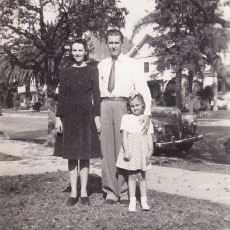
Mother, Daddy, and me in Los Angeles, 1943
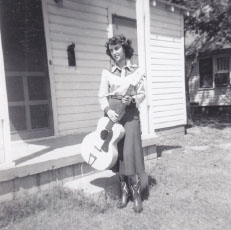
Back in Oklahoma in my “cowgirl” days
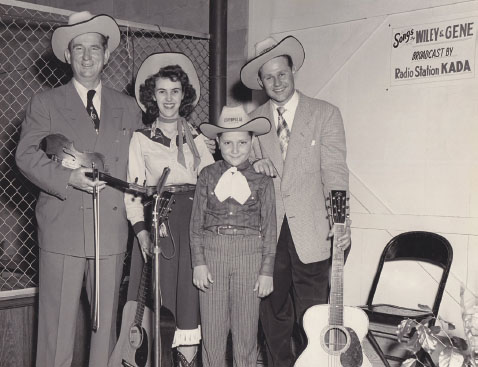
A budding local radio star appearing as a guest on Wiley & Gene’s show

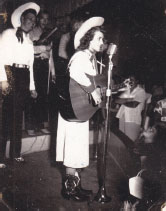
My first public performance with Hank Thompson at the Trianon Ballroom
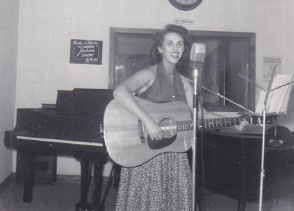
Performing on my daily KLPR radio show, 1954
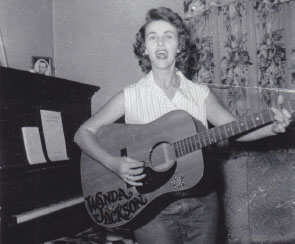
Learning new songs in my parents’ living room
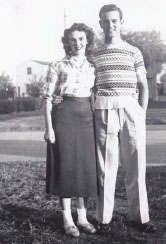
With my first boyfriend, Leonard Sipes

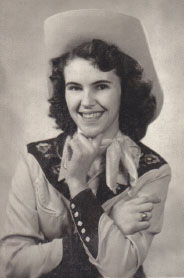
My first professional publicity photo, 1952
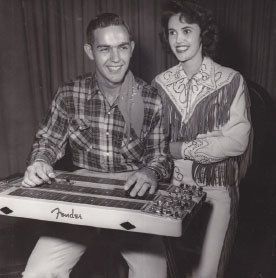
My first Nudie suit, with then boyfriend A.G. Lane
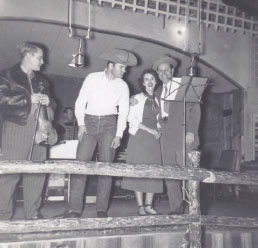
An afternoon rehearsal with Merl Lindsay and band
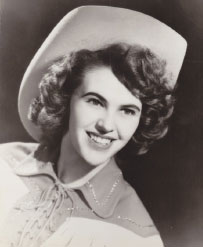
Oklahoma cowgirl all the way!


Decca promo photo with Billy Gray, 1954
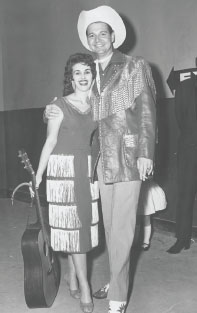
I am where I am today thanks to Hank Thompson!
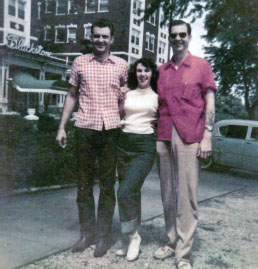
Billy, me, and Hank on one of my earliest tours with Hank and his band

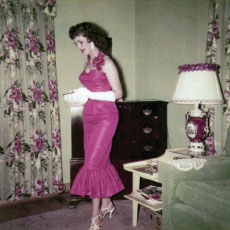
My senior prom dress that I designed and Mother sewed
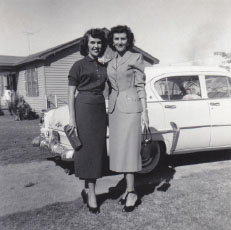
Me and Mother by my first car, a Pontiac. I paid cash!
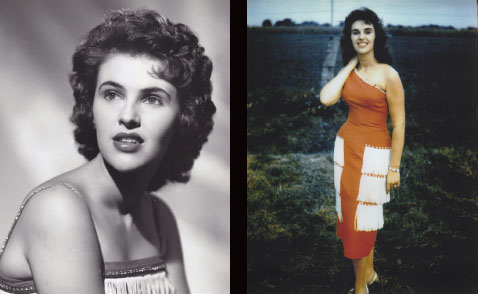
With Mother’s help I embraced a more glamorous image for the stage. The photo on the right is a fan favorite, but it’s always bothered me that two rhinestones are missing on the dress. See if you can spot ‘em!

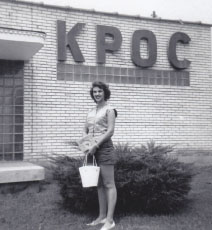
Visiting an Arkansas radio station
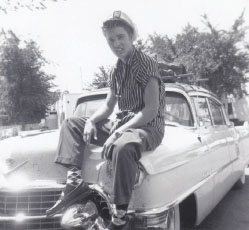
A photo I took of Elvis on his pink Cadillac

Daddy, at the end of a long tour
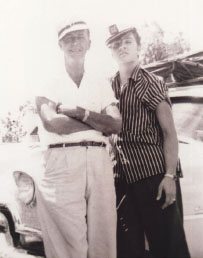
Daddy eventually grew to like Elvis a lot

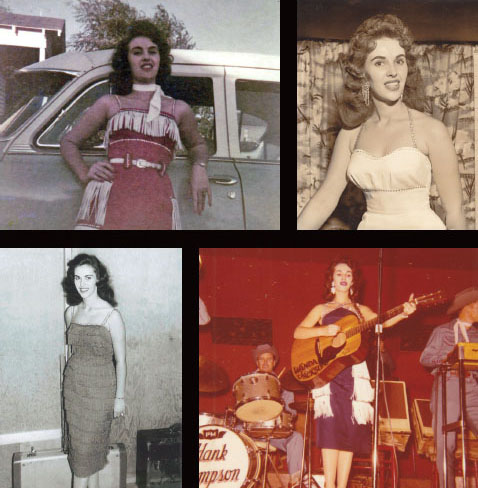
Rock and roll attitude and plenty of exposed shoulders! Bottom right is onstage at the Terrace Ballroom in Newark, New Jersey, November 10, 1957.

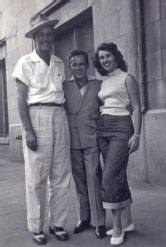
With Daddy and Little Jimmy Dickens, 1956

With Gene Vincent at a DJ Convention in Nashville

Backstage with Ricky Nelson, 1958
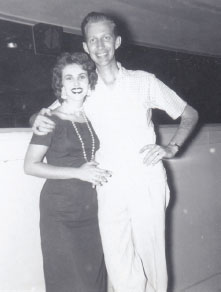
With Porter Wagoner at the Ozark Jubilee

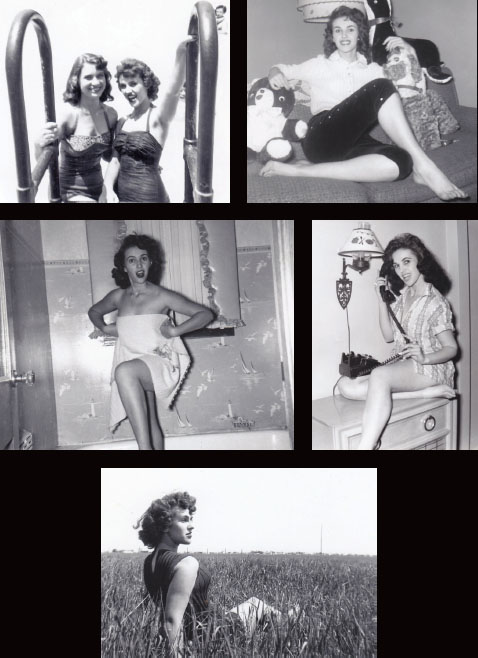
Norma Jean (upper left) and I loved to take “pin-up” style photos in the mid to late ’50s.

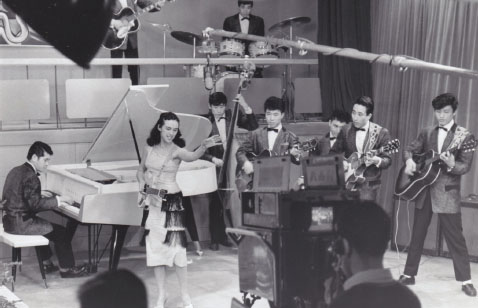
Rehearsal for a Japanese TV show, 1959
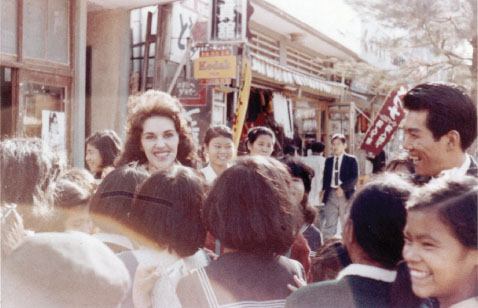
Japan is the only place I ever felt tall!

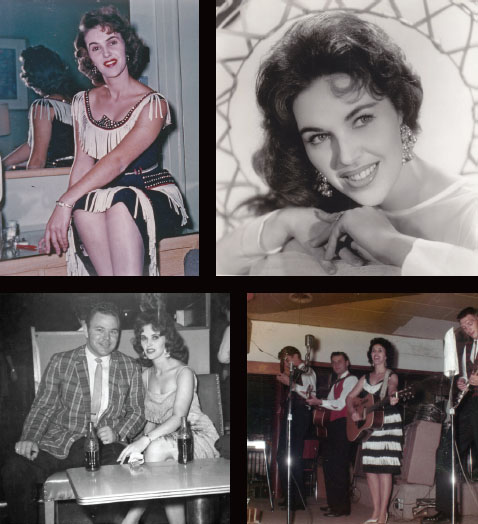
The 1960s were a time of transition when I honed my style and worked with some fantastic musicians, such as Roy Clark, who fronted my band (lower left, photo courtesy of Thomas Sims Archives).

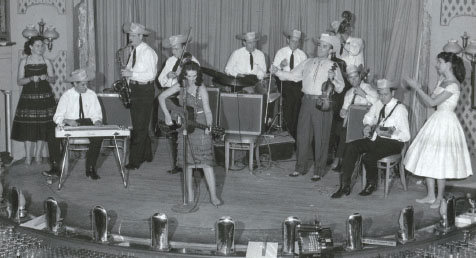
Performing with Bob Wills and his Texas Playboys in Las Vegas
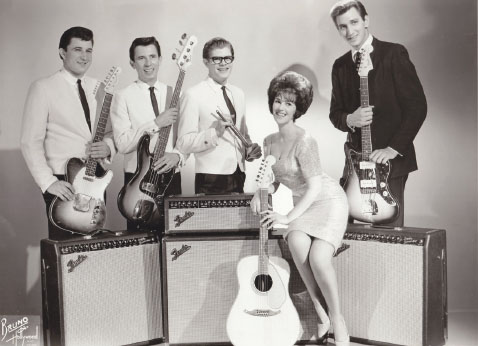
One of the 1960s incarnations of my band, The Party Timers

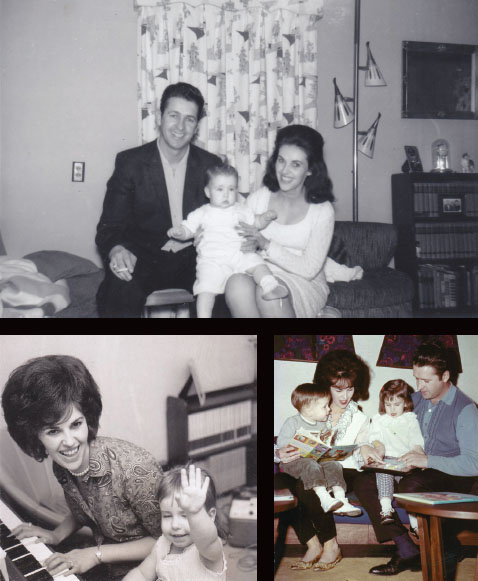
Family became very important in the ‘60s when our daughter, Gina, and son, Greg, appeared.

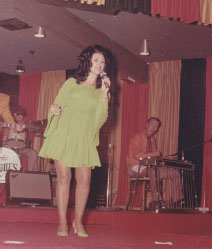
As the ‘60s progressed, the skirts got shorter…
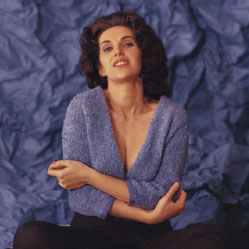
…and the necklines got lower.
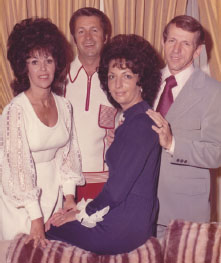
With Rev. and Mrs. Paul Salyer, our wonderful pastor in the early 1970s
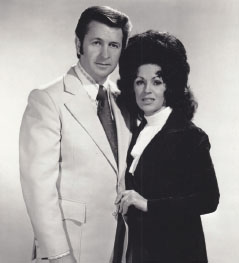
There was a different dress code once we got into the gospel field!

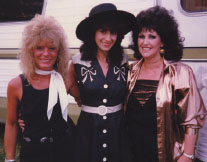
Jann Browne and Rosie Flores, two gals who reintroduced me to rockabilly audiences
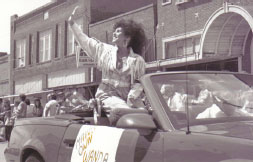
Wanda Jackson Day in Maude, OK, 1989
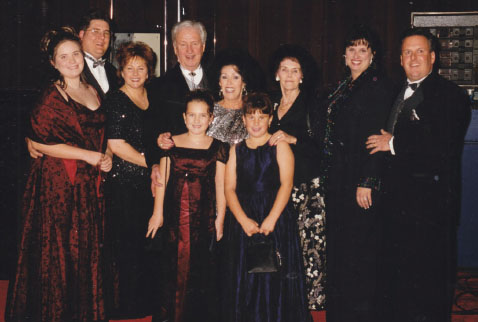
The whole family joined me and Wendell at the 2000 Oklahoma Music Hall of Fame induction. On the left side is my daughter Gina’s family, including her older daughter, Jennifer, and younger daughter, Jordan, along with their dad, Jimmy. On the right side is my son Greg and his wife, Patti, along with their daughter, Jillian. Mother is standing next to me.

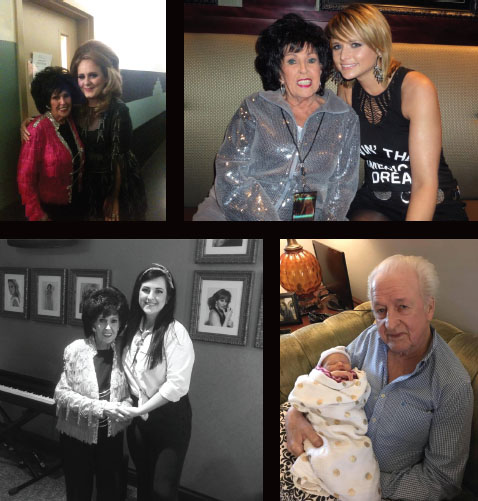
Some of the many important girls in my life, including Adele (who took me on tour with her); Miranda Lambert; my granddaughter (and now manager), Jordan (backstage at the Grand Ole Opry); and my first great-granddaughter, Nellie, who got to meet Wendell shortly before he passed
